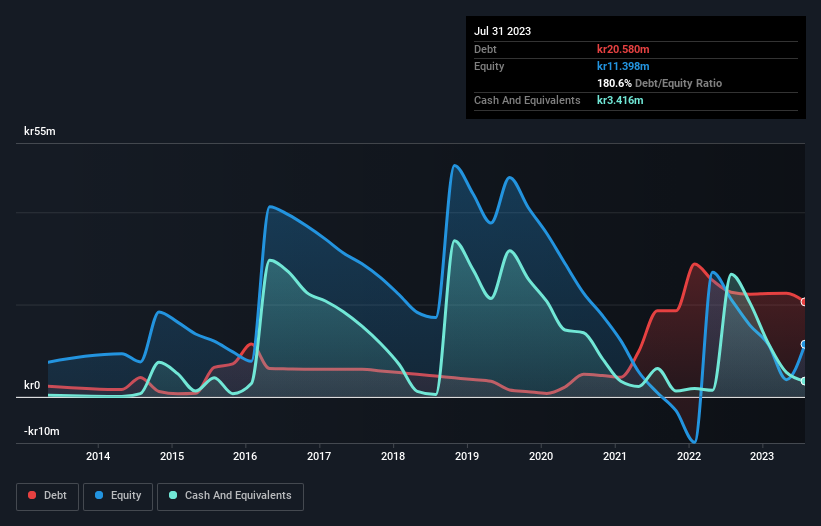- Sweden
- /
- Medical Equipment
- /
- NGM:PHI
Phase Holographic Imaging PHI (NGM:PHI) Is Making Moderate Use Of Debt
David Iben put it well when he said, 'Volatility is not a risk we care about. What we care about is avoiding the permanent loss of capital.' So it might be obvious that you need to consider debt, when you think about how risky any given stock is, because too much debt can sink a company. Importantly, Phase Holographic Imaging PHI AB (publ) (NGM:PHI) does carry debt. But the more important question is: how much risk is that debt creating?
Why Does Debt Bring Risk?
Debt assists a business until the business has trouble paying it off, either with new capital or with free cash flow. Part and parcel of capitalism is the process of 'creative destruction' where failed businesses are mercilessly liquidated by their bankers. While that is not too common, we often do see indebted companies permanently diluting shareholders because lenders force them to raise capital at a distressed price. Of course, debt can be an important tool in businesses, particularly capital heavy businesses. The first step when considering a company's debt levels is to consider its cash and debt together.
Check out our latest analysis for Phase Holographic Imaging PHI
What Is Phase Holographic Imaging PHI's Debt?
As you can see below, Phase Holographic Imaging PHI had kr20.6m of debt at July 2023, down from kr22.7m a year prior. On the flip side, it has kr3.42m in cash leading to net debt of about kr17.2m.

How Healthy Is Phase Holographic Imaging PHI's Balance Sheet?
The latest balance sheet data shows that Phase Holographic Imaging PHI had liabilities of kr9.54m due within a year, and liabilities of kr20.6m falling due after that. Offsetting these obligations, it had cash of kr3.42m as well as receivables valued at kr12.1m due within 12 months. So its liabilities total kr14.6m more than the combination of its cash and short-term receivables.
Of course, Phase Holographic Imaging PHI has a market capitalization of kr152.4m, so these liabilities are probably manageable. Having said that, it's clear that we should continue to monitor its balance sheet, lest it change for the worse. There's no doubt that we learn most about debt from the balance sheet. But you can't view debt in total isolation; since Phase Holographic Imaging PHI will need earnings to service that debt. So when considering debt, it's definitely worth looking at the earnings trend. Click here for an interactive snapshot.
In the last year Phase Holographic Imaging PHI wasn't profitable at an EBIT level, but managed to grow its revenue by 35%, to kr11m. Shareholders probably have their fingers crossed that it can grow its way to profits.
Caveat Emptor
Even though Phase Holographic Imaging PHI managed to grow its top line quite deftly, the cold hard truth is that it is losing money on the EBIT line. Its EBIT loss was a whopping kr18m. Considering that alongside the liabilities mentioned above does not give us much confidence that company should be using so much debt. Quite frankly we think the balance sheet is far from match-fit, although it could be improved with time. However, it doesn't help that it burned through kr32m of cash over the last year. So suffice it to say we consider the stock very risky. There's no doubt that we learn most about debt from the balance sheet. However, not all investment risk resides within the balance sheet - far from it. To that end, you should learn about the 6 warning signs we've spotted with Phase Holographic Imaging PHI (including 4 which are a bit unpleasant) .
If, after all that, you're more interested in a fast growing company with a rock-solid balance sheet, then check out our list of net cash growth stocks without delay.
New: Manage All Your Stock Portfolios in One Place
We've created the ultimate portfolio companion for stock investors, and it's free.
• Connect an unlimited number of Portfolios and see your total in one currency
• Be alerted to new Warning Signs or Risks via email or mobile
• Track the Fair Value of your stocks
Have feedback on this article? Concerned about the content? Get in touch with us directly. Alternatively, email editorial-team (at) simplywallst.com.
This article by Simply Wall St is general in nature. We provide commentary based on historical data and analyst forecasts only using an unbiased methodology and our articles are not intended to be financial advice. It does not constitute a recommendation to buy or sell any stock, and does not take account of your objectives, or your financial situation. We aim to bring you long-term focused analysis driven by fundamental data. Note that our analysis may not factor in the latest price-sensitive company announcements or qualitative material. Simply Wall St has no position in any stocks mentioned.
About NGM:PHI
Phase Holographic Imaging PHI
A medical technology company, develops and markets non-invasive time-lapse imaging instruments in Sweden and internationally.
Worrying balance sheet with weak fundamentals.
Market Insights
Weekly Picks

Solutions by stc: 34% Upside in Saudi's Digital Transformation Leader


The AI Infrastructure Giant Grows Into Its Valuation
Recently Updated Narratives


The "David vs. Goliath" AI Trade – Why Second Place is Worth Billions


The "Sleeping Giant" Wakes Up – Efficiency & Monetization


The "Rate Cut" Supercycle Winner – Profitable & Accelerating
Popular Narratives


MicroVision will explode future revenue by 380.37% with a vision towards success


NVDA: Expanding AI Demand Will Drive Major Data Center Investments Through 2026



